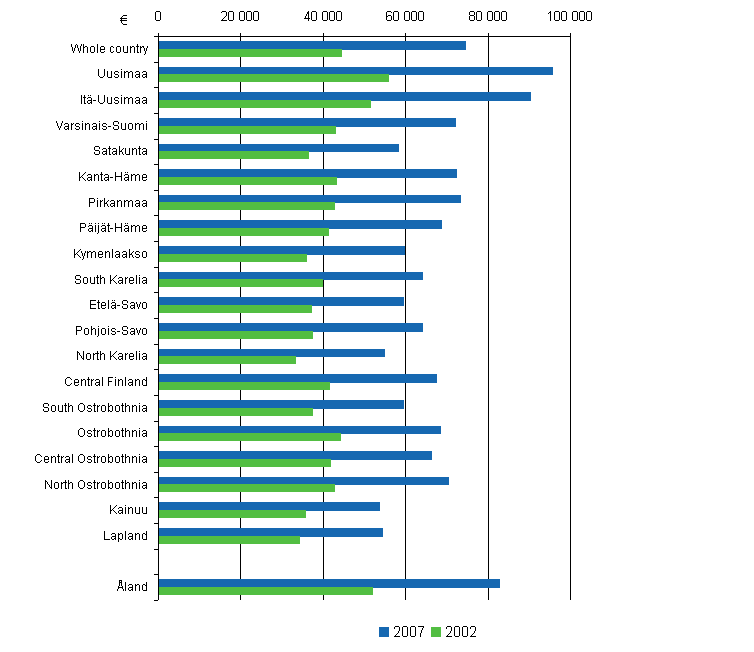Published: 15 October 2008
Average debt per household-dwelling unit EUR 58,540
Fifty-eight per cent of household-dwelling units had outstanding debts in 2007. The total number of indebted households was 1,453,000, which was around 150,000 higher than in 2002. Their debts totalled EUR 84 billion, or averaged EUR 58,540 per indebted household-dwelling unit. The number of indebted household-dwelling units has gone up by 12 per cent and the average debt by 66 per cent since 2002. Over the examined time period the loan stock of household-dwelling units has been growing annually by 12 to 15 per cent. The biggest increase of 14.7 per cent was recorded in 2005. In 2007, the stock of debts only grew by 11.6 per cent.
Outstanding debts of household-dwelling units grew by 80 per cent and their disposable monetary income by 20 per cent between 2002 and 2006. The rate of indebtedness, i.e. debts relative to disposable monetary income, went up from 70 to 98 per cent among them over the examined time period. The rate was highest, or 183 per cent of income, for household-dwelling units in the 24-35 age group. Debts per household-dwelling unit amounted to 1.5 times disposable annual income in the 35-44 age group. However, over the examined period the rate of indebtedness increased most in the youngest age group of under 25-year-olds: from 58 per cent in 2002 to 88 per cent in 2007.
Rate of indebtedness of household-dwelling units by age group 2002-2006, %
| Age | 2002 | 2003 | 2004 | 2005 | 2006 |
| Total | 70 | 76 | 82 | 91 | 98 |
| -24 | 58 | 64 | 69 | 80 | 88 |
| 25–34 | 125 | 139 | 151 | 171 | 183 |
| 35–44 | 104 | 114 | 124 | 138 | 149 |
| 45–54 | 64 | 69 | 74 | 83 | 89 |
| 55–64 | 38 | 41 | 44 | 49 | 52 |
| 65– | 12 | 12 | 14 | 15 | 17 |
The proportion of indebted households was highest in the 25-44 age group at 80 per cent. Slightly over one-half of them had housing loans. They also had the largest loans: their total debt per indebted household was EUR 79,000 and their housing loan per household EUR 94,000. The share of households with a housing loan does not diminish significantly until in the age group of over 55, and even two out of five of them still have housing loans. Other debts divide fairly evenly among households in different age groups, so that well over one-half of households in the age groups from 25 to 54 had them. One-third of the households of under 34-year-olds had study loans. The 25-34 age group had the largest study loans of approximately EUR 6,000 per household.
Households without children had debts less frequently than households with children. One-half of household-dwelling units without children, but only one-fifth of those with one child, and one household in ten if there were more children, had no debts. The amount of debt also went up as the number of children grew: the average debt per household was EUR 42,800 if there were no children, EUR 75,700 if there was one child and EUR 110,500 if there were at least five children. Good one-fifth of households had a housing loan if there were no children, but slightly over one-half if there was one child, and two out of three if there were several children in the household. Housing loans, as well as the frequency and amount of consumer credits, also went up as the number of children increased, although by only very little once there were at least two children.
Seventy per cent of single carer households had debts and 39 per cent housing loans. They had EUR 43,400 debt and EUR 67,000 housing loan per household. Nearly nine households of two adults and children out of ten had debts and 69 per cent had housing loans. Irrespective of the number of children their average housing loan was nearly EUR 100,000.
Since 2002, the numbers of indebted households have increased most in the regions of Uusimaa, Kanta-Häme and Pirkanmaa and least in regions in eastern and northern Finland. In addition to these regions, the shares of households with housing loans also went up in Itä-Uusimaa and North Ostrobothnia. Housing loan size grew most in Itä-Uusimaa, by 75 per cent per household-dwelling unit. Other debts also increased most in Uusimaa and Itä-Uusimaa. Household-dwelling units in Uusimaa, Itä-Uusimaa and Åland had the largest and those in North Karelia, Lapland and Kainuu the smallest housing loans. There were slightly fewer households with housing loans in the Capital Region than in the rest of the country but their loans were nearly one-third larger.
Housing loan per household-dwelling unit with a housing loan by region 2002 and 2007

Source: Indebtness 2007. Statistics Finland
Inquiries: Timo Matala (09) 1734 3422
Director in charge: Riitta Harala
- Tables
-
Tables in databases
Pick the data you need into tables, view the data as graphs, or download the data for your use.
Updated 15.10.2008
Statistics:
Indebtedness [e-publication].
ISSN=2489-3285. 2007. Helsinki: Statistics Finland [referred: 5.1.2026].
Access method: http://stat.fi/til/velk/2007/velk_2007_2008-10-15_tie_001_en.html

